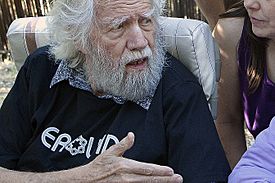Alexander Shulgin facts for kids
Quick facts for kids
Alexander Shulgin
|
|
|---|---|

Shulgin (right) with his wife Ann in 2011
|
|
| Born |
Alexander Theodore Shulgin
June 17, 1925 Berkeley, California, U.S.
|
| Died | June 2, 2014 (aged 88) Lafayette, California, U.S.
|
| Alma mater | |
| Known for |
|
| Spouse(s) | Nina Gordon (deceased) Ann Gotlieb (deceased) |
| Children | 1 |
| Scientific career | |
| Fields | Chemistry, psychology, philosophy, biology |
| Institutions |
|
Alexander Theodore "Sasha" Shulgin (born June 17, 1925 – died June 2, 2014) was an American chemist and author. He was known for his work in creating and studying many different chemical compounds.
With his wife, Ann Shulgin, he wrote two important books: PiHKAL (1991) and TiHKAL (1997). These books shared details from their scientific notebooks. They described their work and experiences with two groups of chemicals called Phenethylamines and Tryptamines. Shulgin did important work in describing how to make many of these compounds. Some of his notable discoveries include compounds from the 2C* family (like 2C-B) and the DOx family (like DOM).
Contents
Alexander Shulgin's Life and Career
Alexander Shulgin was born in Berkeley, California, on June 17, 1925. His parents, Theodore and Henrietta Shulgin, were public school teachers. His father was from Russia, and his mother was from Illinois.
Shulgin started studying organic chemistry at Harvard University when he was 16. He had a scholarship to attend. In 1943, he left college to join the U.S. Navy during World War II.
While serving on the ship USS Pope, Shulgin had an interesting experience. A nurse gave him orange juice before surgery. He thought a powder in the juice was a sedative and quickly fell asleep. When he woke up, he learned the powder was just sugar. This showed him how powerful the placebo effect can be on the human mind.
University Studies and Chemical Discoveries
After the Navy, Shulgin returned to California. In 1954, he earned his PhD in biochemistry from the University of California, Berkeley. He then did more research in psychiatry and pharmacology at University of California, San Francisco.
He worked briefly at Bio-Rad Laboratories. Then, he joined Dow Chemical Company as a senior research chemist. One of his first big achievements at Dow was inventing mexacarbate, the first known biodegradable pesticide. This means it could break down naturally in the environment.
Dow Chemical gave Shulgin a lot of freedom because his pesticide, Zectran, was very valuable. He created and patented new chemicals for Dow. He also published his findings on other chemicals in science journals like Nature. Eventually, Dow Chemical asked him not to use their name on his publications.
Independent Research and Teaching
In 1966, Shulgin left Dow to follow his own scientific interests. He studied neurology for two years at the University of California, San Francisco School of Medicine.
Later, he set up his own laboratory at his home, which he called "the Farm." He became a private consultant, sharing his knowledge with others. He also taught classes at local universities and at the San Francisco General Hospital.
Personal Life and Health
Alexander Shulgin was first married to Nina Gordon, who passed away. He then married author Ann Gotlieb. He spent most of his later life at his home, "the Farm," in Lafayette, California.
In 2008, when he was 82, Shulgin had surgery to replace a heart valve. In 2010, he had a stroke, but he mostly recovered. Around this time, he began to show signs of dementia, which caused him to lose his short-term memory.
On April 17, 2014, his wife Ann shared that he had developed liver cancer. Alexander Shulgin passed away at his home on June 2, 2014, at the age of 88.
Societies
Shulgin was a member of Mensa International, a group for people with high IQs. He often went to Mensa events in California.
See also
 In Spanish: Alexander Shulgin para niños
In Spanish: Alexander Shulgin para niños



